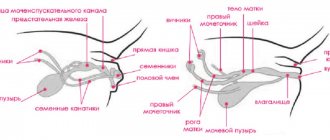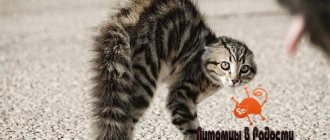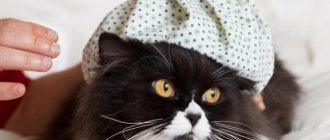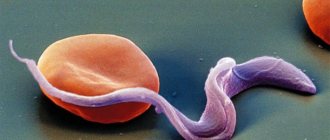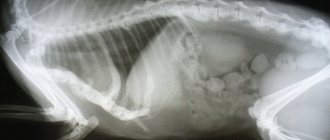Definition and types of enteritis
Enteritis in cats is an inflammation of the intestine, which is accompanied by a significant impairment of its function. Depending on the nature of the disease, the disease can be acute or chronic.
Most often, enteritis is infectious in nature, that is, the disease is caused by various types of microorganisms: bacteria and viruses. Taking this into account, there are 2 types of enteritis: bacterial and viral. Each type is characterized by differences not only in the cause, but also in the clinical picture. Viral enteritis is more common; its varieties will be discussed below.
Any viral enteritis is characterized by a nutritional route of transmission. A pet can become infected from other animals or simply pick up the virus from the street. In addition, you can become infected if your cat eats or drinks from someone else's dishes (which belong to a sick pet).
Rotavirus
In this case, inflammation of the small intestine is associated with special microorganisms - rotaviruses. Small kittens are more susceptible to this disease than adult cats. Therefore, if a kitten is sick, most likely this type of enteritis has developed.
Parvovirus
Parvovirus enteritis (another name is distemper) is the most severe. Unfortunately, all cases of this disease are fatal. The danger of parvoviruses is that they not only cause inflammation of the small intestine, but also lead to a decrease in the number of white blood cells (protective blood cells). In this case, there is a significant decrease in the protective properties of the body, which is the cause of severe disease and death.
Coronavirus
The cause of the development of coronavirus enteritis is also viruses (coronaviruses). Most often, the pathology develops in adults; kittens get sick less often. The disease is characterized by a moderate course, the outcome of the disease largely depends on the timely initiation of therapy.
Coronavirus enteritis
If a cat does not allow you to touch its belly or, when it sees its beloved owner, instead of jumping into his arms, tries to hide in a secluded corner, we can assume that it has coronavirus enteritis. She feels severe pain in the abdominal cavity and tries to avoid any contact, which does not make it even more painful.
Symptoms
The main symptom of coronavirus enteritis is severe diarrhea. The infected animal refuses to eat, its temperature rises, and the cat suffers from frequent (up to ten times a day) diarrhea and vomiting. At first, the stool has a strong odor, later it becomes more watery and almost odorless. The color of the stool has a characteristic reddish or orange tint.
How is it transmitted?
The main source of infection with coronavirus enteritis is the feces of a sick animal. A domestic cat can become infected if they accidentally step on them and then lick their paw. There are suggestions that infection can occur not only through direct contact with feces, but also through airborne droplets, and can also be transmitted from a sick mother to her offspring, but scientifically based evidence of this does not yet exist.
Is it dangerous for humans?
A person becomes infected with coronavirus enteritis extremely rarely, but it is still impossible to completely exclude the possibility of infection entering the body. To avoid infection, it is enough to follow the rules of personal hygiene, never kiss your pet, wash your hands after interacting with the cat with antibacterial soap, keep the apartment clean and clean using disinfectants.
Prognosis and treatment
Coronavirus enteritis is a disease that cannot be cured, but is removed from the cat’s body. If your cat has been diagnosed with coronavirus, the first thing to do is contact an experienced veterinarian.
What is required of you? Strengthen the cat's intestinal walls. You will have to completely abandon industrial feeds and switch the animal to natural food. It is imperative to give raw meat to a sick cat. The cat is wormed at least once every three months. Only a doctor selects medications and treatment regimens. In the case of coronavirus, treatment is strictly individual.
Unfortunately, this disease cannot be cured. But with careful care and supportive therapy, a cat can live with the infection for many years.
Signs of illness
At home, it is quite difficult to determine which pathogen caused the disease. However, the very presence of inflammation of the small intestine can be detected. You can suspect enteritis in a cat based on the presence of the following signs:
- Diarrhea. Diarrhea is the main symptom by which enteritis can be determined in a cat. In this case, bowel movements are abundant, often lose their fecal character, and may be mixed with mucus or blood. Sometimes the stool has a foamy appearance.
- Dehydration. The thing is that with diarrhea, a cat loses a large amount of fluid, which does not have time to be replenished. The more severe the diarrhea, the more dehydrated the cat is. In addition, liquid is lost through evaporation due to high temperature.
- Intoxication syndrome. Viral enteritis is an infectious disease, so all signs of intoxication in this case are clearly expressed. Characterized by weakness, lethargy, the cat constantly sleeps and does not want to play. In severe cases, impaired consciousness (loss of consciousness, convulsions) may occur. In addition, all cats experience an increase in body temperature to febrile levels. This is the body’s reaction to the introduction of an infectious pathogen.
- Eating disorder. The cat often stops eating during this period. In addition, the absorption of nutrients in the small intestine is impaired, so exhaustion can develop, and the cat loses a lot of weight.
These are the main signs of enteritis, indicating infectious inflammation of the small intestine.
Depending on the type of pathogen, other symptoms may appear. For example, in some cases, pathogens of viral enteritis also cause catarrh of the upper respiratory tract. The cat may experience a cough, runny nose and other signs.
Consequences of enteritis in dogs
The complications and consequences of enteritis in dogs are varied. For a long time, digestion is disgusting. Both the liver and pancreas suffer. The inflammation spreads very quickly. Without a diet, the animal will be very ill. Nothing raw (including vegetables) should be given. Only light and quickly digested food (porridge, broth, low-fat cottage cheese). Protein foods will definitely not be given for the first week.
If you do not treat a dog with enteritis, adhesions, obstruction, and even rupture of the intestinal walls may appear (their layers become very loose). This will lead to peritonitis.
In bitches, enteritis can cause complications on the reproductive system. Females may become infertile. Just like that. It would seem that there is inflammation of the intestines, but both the ovaries and the uterus suffer.
Puppies with viral enteritis die without treatment in almost 100% of cases. Even after therapy, complications may develop: the heart suffers (myocarditis), the intestines/liver/pancreas/stomach cope with their functions worse, which leads to a lifelong diet. Paralysis of the hind limbs may occur and resolve after a few months. Do not forget that there is an intestinal form of canine distemper.
, which also leads to enteritis.
Still have questions? You can ask them to our site's in-house veterinarian in the comment box below, who will respond to them as soon as possible.
Treatment
Unfortunately, there is no etiotropic treatment for this disease. Antibiotics are not indicated in this case. Symptomatic therapy includes the following methods:
- Rehydration. For this purpose, infusions of saline solutions (drip administration of saline) are used. If the current is lighter, you can simply give the animal water to drink.
- At high temperatures - antipyretic drugs.
- Antidiarrheals are used only in cases of severe diarrhea, as this interferes with the natural elimination of the virus from the body.
- Diet. On the first day of illness, it is better to give only water, then add gentle and astringent foods: porridge, boiled meat (in the form of minced meat), vegetable puree.
Diagnosis of the disease
The inflammatory process is divided into two main types, which veterinarians take into account.
Firstly, it is acidic, appearing during fermentation. Large amounts of methane and carbon dioxide are released. Secondly , it is alkaline, which provokes the formation of ulcers and ulcers with the formation of ammonia or hydrogen sulfide.
When the pet arrives at the veterinarian, he begins an examination. Examines the oral cavity and performs fecal tests. What is important is that it is not always possible to detect a virus the first time. Sometimes a series of tests are required.
In experiments with cats that carry the virus, tests are taken at intervals of a week . If it is not detected four times in a row, it means that the immunity either coped with the disease, or the pet was not infected at all.
What to test for enterovirus? As a rule, this is a general and biochemical blood test. Antibody testing. The virus most often enters through contact with feces, so a stool examination is carried out, as well as a smear of the intestinal mucosa.
To make sure it is correct, an ultrasound and x-ray of the abdominal cavity are done. In general, the methods differ little between Moscow and the regions. Only in terms of technical equipment and, perhaps, the level of specialists, which is not always the case.
IMPORTANT! At home, you can only carry out restorative therapy, follow a diet and take medications as prescribed by your doctor.
Do cats get coronavirus?
For reference: coronavirus is a cell-free microorganism consisting of single-stranded RNA, nucleic acid and a protein shell. The name is given because of the specific appearance, reminiscent of a crown:
Pets, like all biological objects, are susceptible to viruses of various types and subspecies, including coronaviruses. Some of them have no effect on health, others cause severe illness and can even be fatal.
Coronavirus in cats has an intestinal form. This means that its release and infection of other individuals occurs through the fecal-oral route. Only the cat family is susceptible to this strain; interspecies infection has not been described in veterinary practice. Basically, the disease goes away on its own, no therapy is required.
Statistics show that about 90% of the cat population is infected with coronavirus. But its presence in the body does not mean that the animal is sick.
A negative development of the scenario leading to disease is possible only when the virus mutates, i.e., when its RNA is modified. This occurs in approximately 10% of infections. When exposed to some additional factors, coronavirus tends to mutate, degenerating from a weakly pathogenic strain into a very aggressive strain. After mutation, it migrates from the intestine to other organs and tissues, leading to their severe damage.
Scientists have still not been able to discover the exact causes of the mutation process. But it is believed that the risk factors that provoke modifications include the following events:
- genetic predisposition;
- stress;
- moving;
- vaccination;
- surgical operations;
- hypothermia;
- decreased immunity, regardless of the cause;
- concomitant chronic illnesses;
- other acute infections.
There are currently 2 types of mutated virus known:
- FIP is a coronavirus in cats that initiates the development of feline infectious peritonitis (FIP). Causes serious health problems and often results in death. FIP is in the top three diseases leading to death (after panleukopenia and immunodeficiency);
- FEC - affects the intestinal mucosa, provokes the occurrence of enteritis. The disease is complex, but with appropriate therapy it ends favorably.
The incubation period is 2–4 weeks, but weakened animals become ill on the 3rd–4th day. If after the specified period no symptoms appear, this means that the animal either did not become infected, or the virus did not mutate and your pet simply became a carrier of the infection.
The following individuals are at risk for the incidence of coronavirus enteritis or IPC:
- at the age of up to 1 year (1.5 years - large breeds) and after 10 years (8 years - large breeds);
- having allergies (regardless of the type of allergen);
- suffering from chronic illnesses.
Forms
Based on the severity and manifestation of symptoms, coronavirus in cats is classified as follows:
- asymptomatic – occurs in the majority of cases of infection;
- lung - manifests itself in the form of non-life-threatening (if treated) enteritis and gastroenteritis. The gastrointestinal tract is affected;
- severe course - observed with FIP, all internal organs are involved in the pathological process. The viral agent does not select any specific target; it actively multiplies in the liver, spleen, i.e., where there are many blood vessels. The walls of the capillaries are damaged, blood and effusion seep into the body cavities, especially actively into the abdominal cavity.
There are three forms of severe FIP:
- wet
– characterized by the formation of free fluid (modified exudate) in the chest and abdominal cavity, pericardium, and kidneys; - dry
– the formation of granulomatous inflammation on the internal organs is noted, i.e. the formation of “nodules” that affect their tissues; - mixed
- combines the manifestations of wet and dry forms.
The mechanism for the occurrence of FIP of the wet and dry varieties is as follows: macrophages (cells of the immune system) attack the mutated coronavirus and, unable to cope with it, stick to its surface. The process leads to the formation of globules comparable to the size of capillaries. Due to the accumulation of globules in the capillaries, 2 scenarios are possible:
- the permeability of the walls of these capillaries increases, fluid is released into the chest or abdominal cavity - the disease passes into the wet form;
- blood flow in the capillaries slows down, blood supply to all organs is disrupted, and the disease takes on a dry form. Lack of blood supply gradually leads to complete organ failure.
Routes of infection
Coronavirus enters the body of cats with food, water or in the process of licking their paws, i.e. in a nutritional way. Kittens often become infected from a sick mother. Infection is possible when mating with a carrier individual.
The alimentary method of infection involves 3 phases:
- removal of the infectious agent from the digestive tract of the carrier into the external environment;
- the virus is in a state of suspended animation outside the host;
- the infection enters the cat’s body and the beginning of its life cycle.
Now the same thing, but in simple words: infected individuals spread the infectious agent, excreting it along with feces and saliva. It can exist and reproduce only inside a living biological object; in the external environment it dies after two to three days. It can also be destroyed when exposed to high temperatures, low humidity, ultraviolet rays, or any disinfectant.
The surviving virus enters the body of a healthy individual orally (through the mouth). First, it attacks the epithelial cells of the tonsils and intestines, where it can live for a long time without showing its presence in any way. Therefore, after infection, an animal can be a virus carrier for a long time, without showing any visible symptoms, but at the same time infecting other cats and its habitat with the coronavirus. As already mentioned, for the development of enteritis and IPC, further mutation of the “crown” is necessary, which is facilitated by stress and the influence of other unfavorable factors.
Pets under 2 years of age are most often infected and affected. Viral mutations usually occur in the body of individuals with a weak immune status. The weaker the immune system, the stronger the mutations and the more severe the course of the disease. A strong immune system is able to fight infection by producing antibodies, preventing the virus from changing and affecting vital organs.
The owner of an infected animal should know:
- The feline coronavirus strain is not transmitted to other subspecies of mammals. Therefore, even if this strain is detected in your cat, all other pets are completely safe (of course, except for other representatives of the cat family);
- a pet can become infected with coronavirus, but cannot be infected with viral peritonitis. This disease occurs only when the coronavirus mutates. And the mutation process “starts” only in the body of a specific individual.



